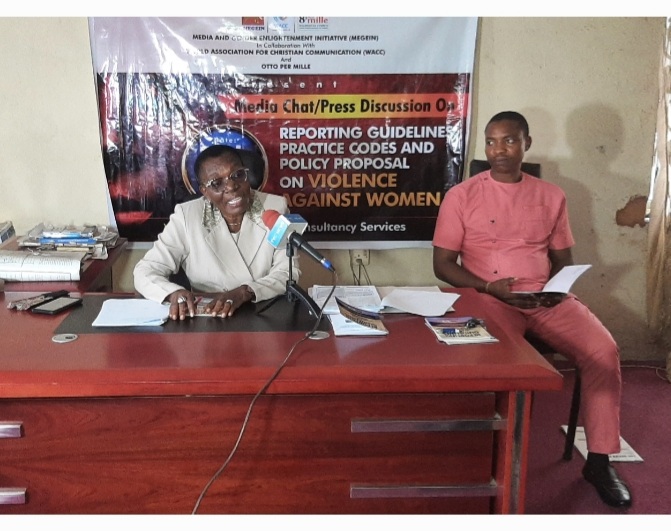·
–
Media and Gender Enlightenment Initiative (MEGEIN), a group sponsored by the Worldd Assocation for Christian Communication (WACC) has decried the increasing rate of violence against women which it said is regrettably under reported.
Speaking with newsmen in Owerri, yesterday,the Executive/Project Director of the group, Associate Prof Nkem Fab Ukozor noted that the rate of violence against women increased tremendously during and after the Covid-19 lock down, pointing out that, “the unfortunate aspect of it is that the media do not report or highlight most of the cases.
She said, “violence against women may not only be physical as there are emotional and psychological dimensions that arise from verbal altercations.
Prof Ukozor pointed out that though men also suffer violence to an extent but the number of such victims is so insignificant.
She further stated that a recent investigation conducted by the group, using some mainstream media as case study showed abysmal reportage of the numerous cases of violence against women.
Worried by the disturbing development, the group articulated and packaged a set of guideline it called “Reporting Guidelines for Mainstreaming Violence Against Women (VAW) Proactive Codes and Policy Framework”, aimed at sensitizing media practitioners on the need to effectively report and bring issues of violence against women to the front burner of public discourse.
Also speaking, Dr Alexander Chima harped on why journalists should not under report or sweep cases of violence against women under the carpet, simply because they were perpetrated by high profile individuals.
He frowned at the attitude of some people who out of fear, intimidation or social status of the perpetrators of violence against women ignore or shy away from reporting such cases.
The reporting guideline packaged in an 8 page pamphlet reads in part, “For an accurate account of VAW cases, reporter should report incidence of VAW from the point of crime scene, arrest and prosecution.
“The reportage of prosecution/trial on VAW cases without adding the voices of the victims, eye witness accounts and perpetrators will not do justice to the stories. The report of trials will only present the views of councils which may not show the seriousness of the offence.
“Story headlines should reflect the actual content of the story. Every issue raised in headline should be treated in the body of the story.
“Language that degrade women should not be used in reporting cases related to VAW. This will ensure that the readers pay more attention to the act rather than the words used to describe the women/girl-child.
“Words/Language that play down on the gravity of the offense should be avoided in reporting cases of VAW.
Parties to the report should form part of the attribution to the VAW stories.
Men should not be reported in VAW stories in such a way that it tries to shade or justify their action.
Images or pictures should be part and parcel of reports on VAW.
“In reporting VAW cases of grieve in the family, the voices of women should not only be heard rather both parents should be heard.
Reports should avoid sensationalizing headlines of VAW stories
Words that show the impact and implication of VAW stories should be used to indicate the seriousness of the story
Reports of VAW which have prominent figures as perpetrators to a crime should not be reported with the intention to protect their image or identity.
“When police officers are alleged to have committed crime in relation to VAW, news stories on these events should not be written as if officers cannot committee such crimes.
“Stories on VAW should be written from the woman rights perspectives, especially as it affects the rights “I women as contained in the Convention on the Elimination All Forms of Discrimination Against Women (CEDAW).
When VAW reports are taken from the point OF court trail or proceedings, reporters should endeavour to refer to the crime scene/crime and confessions obtained.
“Balance and Fairness: Victims and perpetrators should form the essence of the story. In essence, a report will be balance and fair when the victim is also able to give an account as much as the perpetrator did. This will show both sides of the story. Also, reporters should be careful when interviewing the victims in cases where they are still alive.
“Image/Photographs: This helps to bring out the weight of the crime on VAW, especially where it is certain that the said victim committed the crime even when awaiting court trial. This should be more so in cases where the police have ascertained that the crime was committed by the individual through confession. Also, images of victims should be used discretely, especially in VAW Cases in order to avoid stigmatization.
“Accuracy: Story titles (headlines) and the body content should actually reflect what transpired in cases of VAW. There is no alternative to an accurate account.
“Attribution/Sources: To enrich stories on VAW, especially where the crime is grievous, accounts from different sources such as; authorities, eye witnesses and parties to the issues should be used to enrich the story and increase it prominence and believability.
“Protection of Minors: It is already a rule or mark of principle that the images of minors should not be used in the report of stories that has the propensity to tarnish their image. This principle should be strictly adhered to in the case of VAW reporting. Avoid Gory Pictures: Reporters should ensure that the images they use in their reports are not offensive to the eyes. It is not in good taste to have stories that are gory flashed before the readers.
“Protection of Minors: It is already a rule or mark of principle that the images of minors should not be used in the report of stories that has the propensity to tarnish their image. This principle should be strictly adhered to in the case of VAW reporting. Avoid Gory Pictures: Reporters should ensure that the images they use in their reports are not offensive to the eyes. It is not in good taste to have stories that are gory flashed before the readers.
Policy Proposal
There should be more women in print journalism and as editors, as a way of promoting more gender-equality and women-sensitive reporting
Reporters/correspondents should have minimum of National Diploma (ND)/Bachelor of Science (B.Sc) degree before they are allowed to practice the course. This will ensure that they had earlier received knowledge on issues of gender-equality in their course-work before picking up the job. Making journalism profession an all comers affair is gravely in bad taste.”






